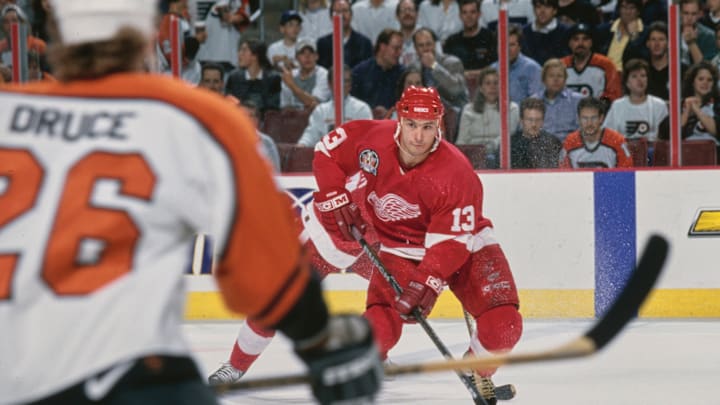If you look at this year's draft, there was one thing evident with the Philadelphia Flyers. They were drafting with size in mind.
Only two of the nine players selected by the Flyers, Max Westergard and Nathan Quinn, stood taller than 6’0” (Quinn is 5'11" while Westergard is 5'7"). Most of them also weigh over 180 lbs. This follows a trend from the year before where all of Daniel Briere's picks, except for Jett Luchanko and Ilya Pautov, were also over 6'0" tall.
This makes sense. After all, historically, the Flyers have tended to play bigger and more physical. And while trends changed in the mid 2000s following the lockout season, the team tried to be physically menacing after rule changes were made. An era of open ice, swift paced hockey was preferred.
However, you have somewhat seen a return of this. The Florida Panthers have won two straight Stanley Cups by embracing a combination of speed and size. They have steamrolled great competition, such as the Carolina Hurricanes and Edmonton Oilers. With their size, they can push opponents out of the way while their speed enables them to score, seemingly, at will.
Back in the mid to late 1990s, the Flyers boasted a team that was over 6'0" tall and 200 lbs. They could outmuscle just about everyone and got into some great physical rivalries with Eastern Conference teams. However, there was a time when their size wasn't enough.
Flyers barrel through the Eastern Conference
This was one of the best teams the Flyers fielded in the Eric Lindros Era. Besides Lindros, there was: John LeClair, Mikael Renberg, Rod Brind'Amour, Eric Desjardins, Chris Therien, Paul Coffey, Petr Svoboda, Janne Niinimaa, Trent Klatt, and Joel Otto.
On the team, only Dale Hawerchuk and Pat Falloon were shorter than 6'0" (both stood at a measley 5'11).
LeClair lead the way with 52 goals and 101 points. Lindros had 33 goals with 82 points. Seven Flyers had more than 40 points, with five players scoring more than 20 goals. In net, the Flyers were solid. Ron Hextall, the ageless vet, went 31-16-5 with a goals against average of 2.56 and a save percentage of .897. His backup was the fiesty Garth Snow, who went 14-8-8 with a goals against average of 2.52 and a save percentage of .903.
The Flyers finished one point behind their arch-nemesis, the New Jersey Devils, for the Atlantic Division title. That didn’t matter, though. Lindros and Co. barrelled through the playoffs.
First up was the Pittsburgh Penguins. Snow starred in net, going 4-1 in the series. With the exception of future Hall of Famers Jaromir Jagr and Mario Lemieux, the Penguins were shut down. LeClair scored four goals while Lindros and Brind'Amour each tallied three.
Next up was the Sabres. Dominik Hasek, the Sabres goaltender, was coming off of a knee injury, a suspension for an altercation with a reporter, and a feud with coach Mike Nolan, and never appeared in the series. Snow started the series with an epic goalie fight with Steve Shields. It was just part of the bad blood between these two teams that had been simmering for years.
While the Flyers were the more talented team, the Sabres hung in every game. They stole a Game 4 overtime thriller. Because of that, Flyers head coach Terry Murray went with Hextall in net for the Game 5 clincher. Again, Brind’Amour and Hawerchuk led the team with six points as Buffalo directed most of their attention to the Legion of Doom line.
In the Eastern Conference Finals, the Flyers faced off against the aged New York Rangers, led by Mark Messier and Wayne Gretzky. After a 5-4 loss in Game 2, Snow was benched for the rest of the series while Hextall went 3-0. Lindros was unleashed, scoring five goals with nine points in the series. LeClair also had nine points while Brind'Amour added four goals. The Eastern Conference was won. Only four games stood between Philly and glory.
Red Wings speed was too much for the Flyers
The Flyers won each series by playing super physical. They slammed into opponents with force. As each series went on, you could see the Penguins, Sabres, and Rangers getting worn down physically and mentally. This allowed the Flyers offense to proliferate and conquer.
Enter the Detroit Red Wings. This was a team who had also rolled over everyone in the West; knocking off the Blues, Ducks, and Avalanche. They were built on speed. The hallmark of the team was the "Red Army Line" of Sergei Fedorov, Igor Larionov, Vyacheslav Kozlov with defenders Vladimir Konstantinov and Viacheslav Fetisov.
As if that wasn't bad enough, Detroit also sported Steve Yzerman, Nicklas Lidstrom, and Brenadan Shanahan. This was a team that could pass with finesse and skate right on by you.
A Flyers team built on smash mouth style hockey couldn't compete. The Wings took all four games, including an embarrassing 6-1 Game 3 rout. Philly scored just six goals in the four games, with Brind'Amour scoring three of them. Murray continued to flip-flop Snow and Hextall in net to no avail.
The defense, with big hulks like the 6'6" Kjell Samuelsson, were torched. Coffey, one of the greatest defenders of all time, was thoroughly embarassed by his former team to the tune of a -5.
Size is good, but talent is better. If you can combine size and speed with a scoring touch, like the Panthers have been doing lately, you can be uber intimidating. Can all of these young Flyers do that for us? We'll see soon enough.
